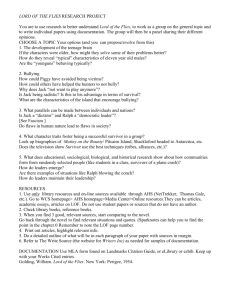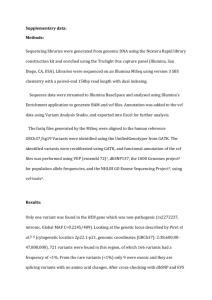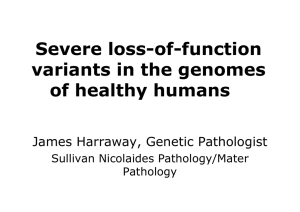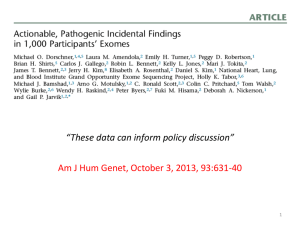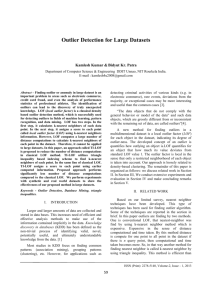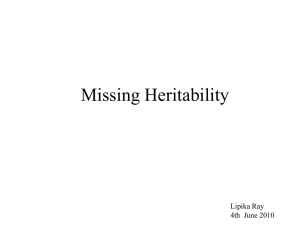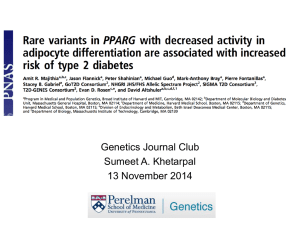Are My Genes Mutated? Analyzing Loss of Function Variants in the
advertisement
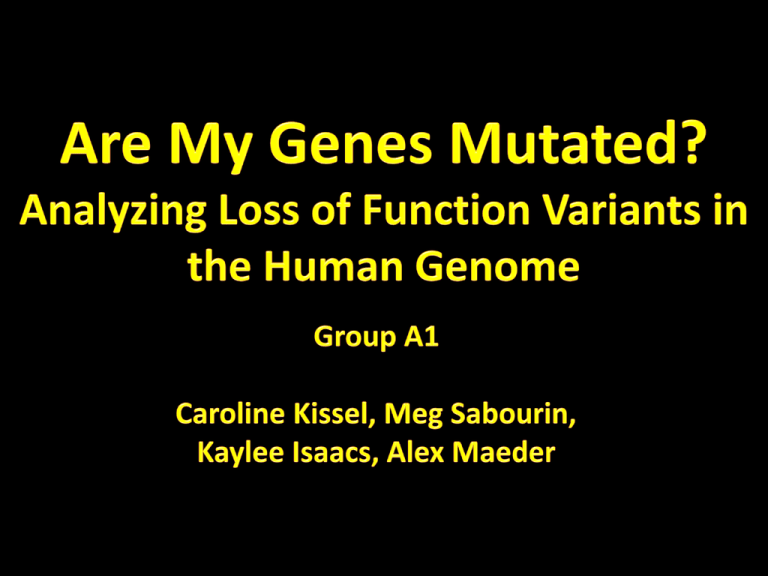
• Such mutations were originally thought to cause severe diseases and/or be very detrimental to the overall health of the person • Recent studies suggest that genomes in healthy subjects can carry 200-800 loss of function (LoF) protein-coding variants. What is an LoF? • “Genetic changes that are predicted to be seriously disruptive to the function of proteincoding genes” (MacArthur, 2012; blog) • Include insertion/deletion DNA reading frameshifts, nonsense mutations (QuintanaMurci, 2012) Experiment • Genomes of 185 individuals analyzed; catalog of nearly 3,000 candidate LoF variants created • The identified candidate LoF variants were put through a series of filters and placed into several overlapping categories: - severe recessive disease alleles in heterozygous state - less deleterious alleles that have impact on phenotype and disease risk - benign LoF variation in redundant genes - sequencing and annotation artifacts (MacArthur, 2012; article) Data/Results • Out of catalog of candidate LoF variants: - 25.0% eliminated as sequencing/mapping errors - 26.8% eliminated as annotation/ reference sequencing errors - 11.1% eliminated as unlikely to cause genuine loss of function • 32.3% of remaining LoF variants found to be partially deleterious, meaning a functional protein could still be made (MacArthur, 2012; article) • 43.5% of original LoF candidates remained after filtering tests • These variants were found to: - contain stop codons, disrupt splice-sites, or result in insertions or deletions that change DNA reading frame - primarily be enriched in low-frequency alleles; those present in higher frequencies are either present in poorly evolutionary conserved genes, multigene families, or have few proteinprotein interactions (MacArthur, 2012; article) • Overall, the identified LoF variants are extremely rare; majority of the identified candidates are found in less than 2% of population • 26 known severe recessive disease-causing mutations identified in LoF set • 21 LoF variants identified in known novel disease-causing mutations (MacArthur, 2012; blog) Discussion • The low frequency of deleterious LoF variants could be explained by purifying selection; therefore variants associated with severe diseasecausing mutations are prevented from reaching high frequencies (MacArthur, 2012; article) • Contributes to the “less is less” hypothesis, which states that LoF variants will be counter-selected seeing as they cause disease (Quintana-Murci) Take Home Message • All human genomes carry around 100 LoF variants. However, the majority of these do not cause true loss of gene functioning and the ones that do cause severe diseases are extremely rare. Literature Cited: MacArthur, Daniel. "A Systematic Survey of Loss-of-Function Variants in Human Protein-Coding Genes." Science Magazine: Sign In. The American Association for the Advancement of Science, 11 Jan. 2012. Web. 18 Nov. 2012. <http://www.sciencemag.org/content/335/6070/823.full>. Quintana-Murci, Lluis. "Perspective: Gene Losses in the Human Genome." Science Magazine: Sign In. American Association of the Advancement of Science, 17 Feb. 2012. Web. 18 Nov. 2012. <http://www.sciencemag.org/content/335/6070/806.full.html>. MacArthur, Daniel. "All Genomes Are Dysfunctional: Broken Genes in Healthy Individuals." Web log post. Genomes Unzipped. WordPress, 02 June 2012. Web. 18 Nov. 2012. <http://www.genomesunzipped.org/2012/02/all-genomes-aredysfunctional-broken-genes-in-healthy-individuals.php>.
